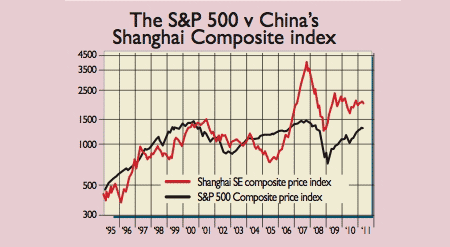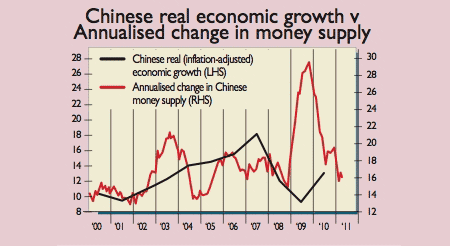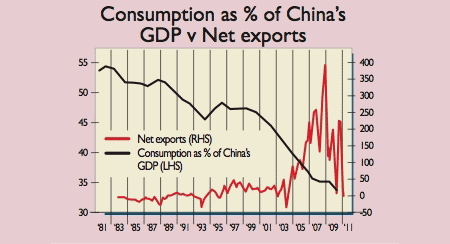China is heading for a fall – here’s what it means for you
Over the past few years, China's rampant growth has grabbed investors' imaginations. But now it shows signs of slowing. James Ferguson looks at the challenges it faces, and what you should buy when the slowdown hits.
China needs to end its economic dependence on exports, by encouraging consumers to spend. But getting there won't be easy, warns James Ferguson.
The two most crowded trades in the world are long emerging market stocks and short developed market government bonds. Perhaps this alone explains why emerging markets are all down so far this year, while developed market government bonds are all up (that is, yields are lower).
This is not the way it was supposed to be. Almost everyone believed that the next ten years belonged to the emerging markets, while developed economies would be trapped in the doldrums. China, in particular, grabbed the global imagination as its seemingly unstoppable growth thrust its economy into the number-two slot behind America. Economists vied with each other to predict when, on the current trajectory, China would usurp the US to become number one. Yet the Shanghai Composite Index of stocks is down on the year so far. Global markets are signalling a loss of faith in the emerging market story. Are they right to be worried?
Subscribe to MoneyWeek
Subscribe to MoneyWeek today and get your first six magazine issues absolutely FREE

Sign up to Money Morning
Don't miss the latest investment and personal finances news, market analysis, plus money-saving tips with our free twice-daily newsletter
Don't miss the latest investment and personal finances news, market analysis, plus money-saving tips with our free twice-daily newsletter
The two big problems with China
Winston Churchill once described Russia as a "riddle, wrapped in a mystery, inside an enigma". If he were alive today, he would apply that expression not to Russia, but to China. There are many reasons why China is so very hard to peer into: its size, its secrecy, and its paranoia, to name but three. However, two big problems stand out. First, the data: there's very little of it and what there is can't be relied upon. Second, China has a command economy, which means it is run along lines that don't always make sense from a neo-classical economist's point of view.
Take the unreliable data first. China seems to have been growing at around 12%-14% a year over the last decade. But the way real (inflation-adjusted) GDP is calculated is to take the nominal GDP figure and deduct the inflation rate. So if the published inflation rate is artificially low, then real GDP growth gets overstated. Chinese consumer price index (CPI) inflation is currently 5.4% about the same as the UK retail price index (RPI) inflation. Yet China's economy is in a very similar position to India's, where inflation is running at well over 8%. It's also well known that China's economy seems to go into recession even when GDP growth is quite high (around 6%): perhaps this is because that's the extent to which inflation is higher than the official figure.
Developing economies like China and India are much more sensitive to changes in food and energy prices than developed ones (where services and labour costs make up a much higher proportion of consumption). The Tianammen Square uprising was triggered by high food price inflation, for example. So the authorities are very aware of how dangerous hefty cost-of-living inflation could prove. However, in order to hold the yuan exchange rate down, interest rates must also be kept low so low in fact that they're negative, and possibly deeply negative if inflation is being understated. The Singapore Straits Times estimates that Chinese wage inflation has been running at a double-digit rate now for at least the last two to three years.
The second problem in understanding China is that, as a command economy, the speed and direction of the economy is determined at a centralised level by politicians operating with potentially incomplete or inaccurate information. At China's stage of development, this is not unusual. Japan, Singapore and Korea all followed centrally-planned growth strategies based on industrial export and supporting infrastructure models.
But it's important to realise where the modern China story has come from.After the Asian Crisis in 1998, China was arguably left with a banking crisis, which was at least equal to the one now besetting the West. By some calculations, non-performing loans (NPLs) from banks mainly to unprofitable state-owned enterprises (SOEs) were as much as 50% of GDP. The Chinese solution was to grow its way out of trouble by setting borrowing and lending rates at an artificially low level so as to keep credit flowing to zombie businesses and keep the currency tied to the US dollar to aid exporters.
In an open economy, this might have led to local people sending their money abroad to get higher yields, so China has capital controls in place to keep savers' funds in Chinese bank accounts, no matter how low the return. Household saving is very high in developing economies because there is little state provision for healthcare, unemployment or old age. But the capital controls and low returns on deposit accounts mean that domestic savers have every reason to speculate in assets such as stocks and property.
China's growth in the early part of the last decade was sufficient to save the banks' bad loans. But profitability was very low and the stockmarket didn't like it much, pretty much halving between 2001 and 2005 (see chart A below). For stockmarket investors, the China story really only started in 2006 and it's been a real roller-coaster ride. Pick the right start date in 1992 and the S&P 500 has actually beaten the Shanghai Composite.
How high oil prices helped China
What helped stocks to go higher was the oil price rising above $45 a barrel in 2005. This made China's coal reserves economically viable (China has the world's second-largest coal reserves after the US). GDP growth (and pollution) accelerated as manufacturing facilities and power stations clustered around cheap and plentiful coal supplies. China's export machine, driven by cheap credit, an artificially low currency and now cheap power supplies too, went into overdrive. Then in October 2008 it all shuddered to a halt. The stockmarket collapsed as Western economies nose-dived and demand for exports plunged. The central planners went for a radical solution. The NPLs from the Asian crisis had all but disappeared due to the high growth from 1999 to 2007, so the central planners went for another huge credit push. Banks were told to lend, which pushed money supply growth up to an annualised rate of 30% in 2009 (see chart B below).
But the China of 2010 is not the same beast as the China of 2008. The plan pursued by the central authorities in the early 2000s was born of desperation to bail out the banks. Rising oil prices gave them a lucky break by making their coal reserves viable. But this China was a low-value-added, volume-based export machine earning huge quantities of dollars, which it dared not change back into yuan in case the dollar peg broke. China had to lend to the US so the US could buy more and more of China's cheap goods and import dis-inflation.
2008 changed all that. The collapse in export demand growth, probably permanent, meant China needed an immediate boost to prevent recession. Infrastructure spending, which averaged 38% of GDP between 1978 and 2008 has surged, unsustainably, to 50% of GDP. It is highly doubtful that all this extra investment has been efficiently or profitably employed. Meanwhile, demand for Treasuries (US government bonds) from domestic US savers has surged, because the private sector is now net saving rather than spending. Domestic private saving was able to finance 0% of the American budget deficit in 2007, but that rose to 36% in 2008, 85% in 2009 and 77% in 2010. This has left less US debt for the Chinese to buy with their dollars. So instead they've had to buy dollar-denominated commodities, fuelling painful raw material inflation at home and abroad.
China is also now a net importer (see chart C below). With its export model now defunct, and unable to maintain the recent pace of infrastructure building, China must now promote the sector that the bulls get most excited about: consumption. Chinese consumers paid a terrible price during the last decade for the capital controlled, low interest rate, low yuan export-drive necessary first to bail-out the banks and then to save China from the collapse in demand from the West. The consumption share of GDP had already slipped from 55% in 1982 to 47% in 1998. But from the Asian Crisis onwards, it has plummeted to just one third of the economy (see chart C below).
Unequal and erratic wage and asset inflation has created a nation of urban, coastal haves' and rural, interior dwelling have-nots'. Little wonder that the government's latest five-year plan targets improving the workers' lot. Once more, China's central planners are being forced into a reactive rather than an evolutionary strategy for tackling the economy. The challenge is to make sure it goes smoothly. But the outlook is not encouraging.
For starters, reversing the strategies that drove the export surge and, more recently, the infrastructure binge at the expense of consumption, could prove disastrous. A stronger currency, for example, would reduce food-price inflation (as imports become cheaper) and increase consumers' buying power. But with profit margins at the SOEs so thin, this could potentially come at the expense of corporate profits (as export prices would rise) and might push banks' bad debts higher.
By the end of their infrastructure and manufacturing growth phases, Japan and the Asian Tigers were producing higher value-added products and had improved reputations for quality, reliability and technology. China is still known for its low-end assembly, T-shirts and trainers.
Chinese exporters can't compensate for a stronger currency by moving production offshore or by moving up the value chain. So attempts to date to sap the inflationary trend have had to be domestic. This has largely involved trying to slow bank lending by increasing banks' reserve requirements (the amount of money they have to hold against the loans they've written). But because so much lending goes on off balance sheet, this is having little effect. Raising rates when companies have thin profit margins risks sending China's highly-leveraged industrial and infrastructure sectors into the red. But if inflation and credit growth both continue at current rates, Beijing may panic, hike rates and trigger a sharp contraction.
Even a controlled move towards consumption will prove tricky. Because consumption is so much smaller as a proportion of GDP than other sectors, it needs to grow at a much faster rate than the other sectors slow down. Infrastructure, in particular, is problematic because it tends to be all or nothing, so slowdowns can be very abrupt.
China's three big challenges
Investors looking to play the China story need, therefore, to be aware of three things. Firstly, the China story is actually a series of centrally-planned stories that merge into each other on a rolling basis. While growth looks much higher than in developed countries, as you'd expect at this stage of development, it may well be overstated because inflation is underreported. This means that those doing the central planning are operating with unusually imperfect information. Historically, capitalism's invisible hand' has proved a better (though clearly not perfect) way of directing resources efficiently. So the scope for a major policy mistake is significant.
In addition, politics could always supersede economics if the transition towards raising consumption's share of GDP hits a bump, requiring a military crack-down. China's incentive to redirect domestic strife into an international dispute should not be underestimated.
Second, it may not just be the end of US money printing (QE2) that spells the end for the commodity bull market. If China decides to redirect more share of GDP towards consumption, exports may fall, meaning fewer dollars to recycle through commodity purchases. Alternatively, tighter monetary policy may not just damp inflation, but economic growth as well. Either way, a contraction in the share of infrastructure spending could prove abrupt and even traumatic.
Third, a whole host of competitive structural advantages are about to reverse. China's demographic time bomb, the legacy from the one-child policy, starts to kick in this decade. By 2020, the labour force will be shrinking and the dependency rate (the number of retirees per worker) will grow exponentially from then on. Meanwhile, China is already a net importer of coal. So its other great marginal competitive advantage, after plentiful cheap labour, has already turned. Indeed, peak coal (when China hits the point where it's getting as much coal out of the ground as it ever will) is due to hit in 2015. Mongolia (to the north of China) has vast untapped coal reserves of its own, presenting China's central planners with atempting arena for military action.
The China story has already moved on from the cheap labour, cheap coal, export model and cannot continue to be driven by this rate of infrastructure spending. The next phase, according to the latest five-year plan, recognises the demographic, social and environmental challenges. However, lower rates of export growth and now infrastructure investment are most likely to crimp economic growth.
Even assuming there is sufficient growth in income to achieve the desired shift to consumption, Chinese industry may not be best orientated to service Chinese consumer demand. Global consumer giants, such as US, Japanese and German firms, will be the best ways of playing the story. Investors must prepare for slower growth in China, where China imports more higher value-added goods than it exports, and where foreign stocks are the best way to play the trend.
A

B

C

What to buy when the slowdown sets in
If China slows down, the impact will be felt most painfully in the commodities market. As Jeremy Grantham of US fund manager GMO noted in a recent research report, Chinese demand has been a key driver of commodity prices, with China accounting for nearly half of the world's iron ore, steel, lead, and coal demand, for example. So "if China stumbles" then "commodity prices will decline a lot". On top of this, with quantitative easing set to end in the US this month too, the outlook for raw materials is gloomy. As a result, we'd suggest now is a good time to sell out of mining stocks and basic industrial commodities. If you are inclined to trade currencies, then being short commodity currencies, such as the Australian dollar, may be a good trade on a Chinese slowdown, although remember that betting on the foreign exchange markets is risky and can be extremely volatile.
As for what to buy: while the MoneyWeek team aren't keen on government bonds, government debt may well see a rebound as investors seek safe havens if the Chinese economy slows sharply. High-yielding defensive stocks should also be on your shopping list: any threat to global growth will push investors towards more defensive stocks. A straightforward way to get exposure to defensive plays in the UK market is via Neil Woodford's Edinburgh Investment Trust (LSE: EDIN) , which is heavily weighted towards blue-chip stalwarts in the pharmaceutical and tobacco sectors.
As for China's future as a consumer economy, if it does manage to make the transition then this could be good news for developed world manufacturers. The likes of Germany in particular would stand to benefit from a more demanding Chinese consumer, not to mention Britain's gradually reviving manufacturers. But given that markets are likely to retreat if Chinese growth disappoints, there will probably be better opportunities ahead to buy into these sectors at lower prices.
This article was originally published in MoneyWeek magazine issue number 542 on 17 June 2011, and was available exclusively to magazine subscribers. To read all our subscriber-only articles right away, subscribe to MoneyWeek magazine.
James Ferguson qualified with an MA (Hons) in economics from Edinburgh University in 1985. For the last 21 years he has had a high-powered career in institutional stock broking, specialising in equities, working for Nomura, Robert Fleming, SBC Warburg, Dresdner Kleinwort Wasserstein and Mitsubishi Securities.
-
 Coventry Building Society bids £780m for Co-operative Bank - what could it mean for customers?
Coventry Building Society bids £780m for Co-operative Bank - what could it mean for customers?Coventry Building Society has put in an offer of £780 million to buy Co-operative Bank. When will the potential deal happen and what could it mean for customers?
By Vaishali Varu Published
-
 Review: Three magnificent Beachcomber resorts in Mauritius
Review: Three magnificent Beachcomber resorts in MauritiusMoneyWeek Travel Ruth Emery explores the Indian Ocean island from Beachcomber resorts Shandrani, Trou aux Biches and Paradis
By Ruth Emery Published